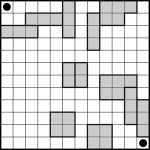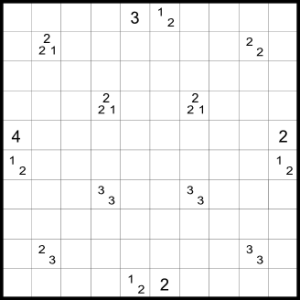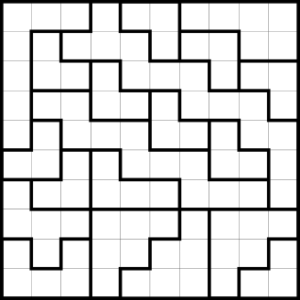Update – Thanks to Bram for pointing out that the Diayajilin actually works without the added arrows.
Right then. I haven’t posted all week since I’ve not been well. This basically meant I’m behind all my plans by 2 days, and seeing as I’m traveling for a week from Sunday, that leaves me really less time to do everything I want to. So anyway, this was the best I could force out in the little time I had. Some of the puzzles have quick fixes, one of the Yajilins has a segment given, and there are some other places where I decided to experiment a little like the Division fleet. Anyway, practice is practice, and for what its worth, here they are. It’d be weird to post these after the test anyway, and weirder to just put them away. You can find some others from other sources on the Discussion thread for Di… Anyway, I actually made a Diagonal variant of Yajilin a long while ago here. Its got some different formatting but I think the rules are pretty much the same. I must thank my testers Tom and Murat Can Tonta for getting this done so fast. I have tons of things left to do. I shall resume posting on the 7th/8th September mostly, and will mostly have a good announcement lined up too 🙂
So in order, the below puzzles are – Diayajilin(2), Disposition(with Fleet), Diversion, Diversion without Borders, Division(with Fleet), Dioxides(with 21 Os atoms, though I don’t see how that affects the solve anyway). All rules taken from the IB here. Unlike my usual style, all rules are below the respective puzzles.
Enjoy!

Diayajilin – Blacken some cells so that you can draw a single closed loop through all remaining white cells. Black cells cannot be adjacent to each other. The loop cannot touch or cross itself. Each number in the grid shows how many black cells can be seen in the direction of the arrow. Numbered cells cannot be blackened. Addendum – A loop segment is given in one of them. Also, clues pointing in two directions indicate that many number of black cells for each of the directions, and not the sum of them.


Disposition – Place the given fleet following the grid lines. Ships cannot touch each other even diagonally and cannot occupy cells with digits. Each number in the grid shows how many ships (Rectangles or Squares) are located in the horizontally, vertically and diagonally adjacent cells. Addendum – “?” is a digit not given to you, so it basically just means that there’s no ship segment on that cell.


Diversion – Each number in the grid shows how many mines are located in the horizontally, vertically and diagonally adjacent empty cells. The object is to reveal all the mines in the grid, providing that a cell can contain only 1 mine. Mines cannot occupy cells with digits.

Diversion without Borders – Cut the grid into 1×2 rectangles. Each number in the grid shows how many mines are located in the horizontally, vertically and diagonally adjacent empty cells. The object is to reveal all mines providing that a 1×2 rectangle can contain only 1 mine. Mines cannot occupy cells with digits.

Division – Place the given fleet and 20 mines into the grid. A cell can contain only 1 mine. Each number shows how many parts of ships OR how many mines are located in the horizontally, vertically and diagonally adjacent empty cells. Mines and ships cannot occupy digits. Ships cannot touch each other and cells with mines, not even diagonally.

Dioxides – Place letter “s” in 21 cells with letter “O”. Cells with Os(Osmium atom) cannot touch each other, not even diagonally. These, along with 2 other oxygen atoms O, will form 21 Osmium dioxides with either a 180 degree turn at the Os atom, or a 90 degree turn. i.e. atoms can’t be connected diagonally. Addendum – Test puzzle will have 27 wherever 21 is above.


















































